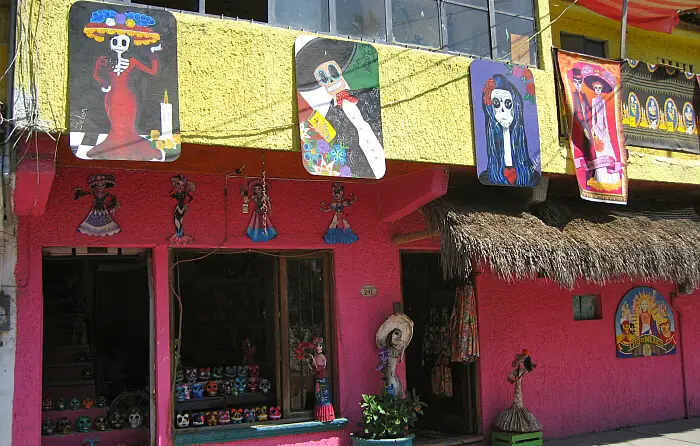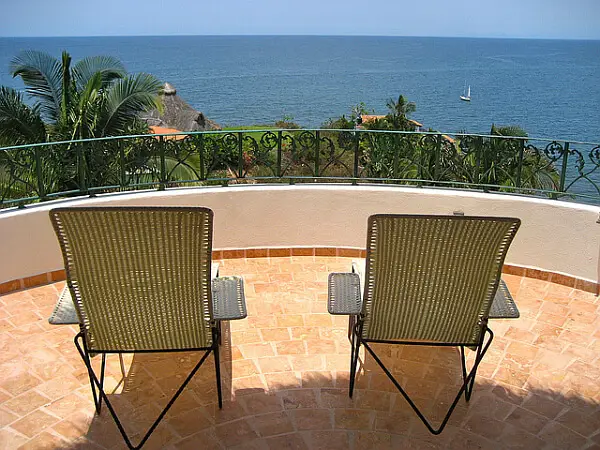A Rumi of Her Own in Sayulita
A Rumi of Her Own in Sayulita
Story and photos by Anna Elkins
While staying in a Mexican villa named for a love poem, a solo woman traveler rediscovers her voice.

I freeze in the middle of the room.
Aloud, I had just said, "It is good I came alone," and my voice suddenly returns to me magnified, as if I were standing in an acoustic chamber. And then I realize I am. I look up; I am standing directly beneath the center of the round, soaring cupola.
I thought I would come to Sayulita to find my voice again. Instead, it found me. It found me saying gracias for marlin fish tacos. It found me asking the gardener for the Spanish name of hibiscus. It found me ordering a smoothie of fresh greens without knowing what kind of water they'd been washed in. It found me saying "no" to Nacho—the Pixar-designed beach boy—and "yes" to wine with a gallery owner. It found me singing along to a DJ'd wedding at night and speaking promises to the sea in the morning. It found me.
Maybe I hear this as I stand beneath the cupola, the ceiling of Casa Rumi, on the top floor of Villa Poema de Amor. (Yes, you can stay in a love poem. I highly recommend it.) The other two floors are named after equally passionate poets: Neruda and Lorca. The curvaceous, white villa rises from seaside hills in a Mexican village once known mostly to fishermen. Now, sponsored surfers and paddleboarders share the waters with the fishing boats, and everybody stops what they're doing to watch the best show in town, offered daily, free of charge: the sunset.
My first night at the villa, I walk back along the beach after watching that glowing show. Past the palapa-roofed bar, Camarón. Past the open stretch of shore where fishermen hold poles and nets. Past the twenty-somethings playing volleyball. Past the expats seated at tables on the sand in front of Don Pedro's. Then up the dirt road that winds toward the Playa de los Muertos. By then, it is turning dark—the sky a clear, gloaming blue.

Villa Poema de Amor stands next to the graveyard. As in: you can step off the stone path leading to the gate right onto the mint-green gravestone of "Woody, gone Surfin'" or one of the more traditional local graves adorned with pastel wreaths sheathed in weathered plastic. The eternally quiet neighbors are a good reminder to live and to be glad of living.
Back on the rooftop terrace, I stand at the railing, looking to the invisible line of sea and sky. Below, a sailboat. Above, the Big Dipper—upside down—scooping the heavens up and pouring them over the earth.
"Cupola" comes from the Italian word for cup—an upside-down cup. Between the constellation and the cupola, I feel a generous dose of goodness pouring down. I am glad to be living.
The next morning, I rise with the fishermen. I drink my coffee as their nets sieve the sea and my pen lines the page. I even write a prayer of thanks for what they catch; I'll have it for lunch in my tacos.
On the way out the gate, I try to practice my latent high school Spanish with the gardener, Francesco, but find it nonexistent. Relying on the only universal tongue, sign language, I ask him the Spanish word for hibiscus. From mutual arm waving and pointing, I gather that, in this region around Sayulita, the flower goes by obelisco. The flashy red flowers open for day and close for night, their obelisk-like stamens antennae for sun. I thank Francesco for writing the word for me and continue down the hill.

I don't want to be late. I committed to a week of 9 a.m. yoga at Hotelito Los Sueños. Commitment sometimes works best with purchase, so I bought the multi-day pass. Every morning, beneath the grass roof of the palapa, on an open rooftop terrace, locals and visitors stretch limbs and remember to breathe while instructors like Guillermo say, "eeeen-hala, ehhhx-hala."
Afterwards, we order smoothies from the rooftop juice bar on the other side of the palm tree. Chia + papaya + banana + apricot + spinach + amaranth = mmmmm. It is easy to strike up conversations among seatmates, the instructors, and the happy woman working the blender. The Hotelito juice bar is a great place for solo writers with hermit tendencies to meet people.
The beach, not so much. Later that night, walking back from what has become my regular sunset stroll, I pass an amorphous group of the twenty-somethings. This time, one of them breaks away, bottle of Pacifico in hand.
He delivers an original line: "I saw you walking."
I smile. "Yes, I do quite often."
Extending his beer in a flourish, he goes on. "My name is Ignacio. You can call me 'Nacho.'"
Without waiting for acknowledgment of this fact, he continues, "You have boyfriend? Does not matter. Me: I am drama free." He winks.
Copyright (C) Perceptive Travel 2016. All rights reserved.
- Deep Red Threat in Malaysia by Marco Ferrarese
- Locked Out of Canada by Gillian Kendall
- World Music Reviews
- Travel Book Reviews
Books from the Author:

Buy The Heart Takes Flight at your local bookstore, or get it online here:
Amazon US
Amazon Canada
Amazon UK

Buy The Honeylicker Angel at your local bookstore, or get it online here:
Amazon US
Amazon Canada
Amazon UK

Buy The Space Between at your local bookstore, or get it online here:
Amazon US
Amazon Canada
Amazon UK

Buy And: The Story of More at your local bookstore, or get it online here:
Amazon US
Amazon Canada
Amazon UK

